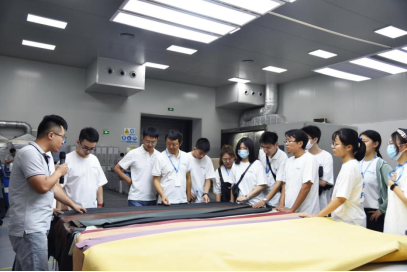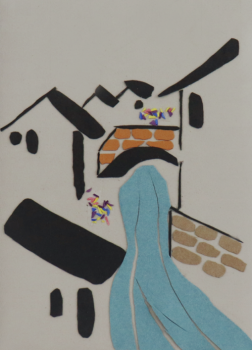Abstract
Summer practice courses for undergraduates of Tsinghua University are a medium for students to better engage in practice and broaden their horizons. From August 18 to 26, 20 students majoring in Creative Design and Intelligent Engineering (CDIE), Xinya College and from the Department of Industrial Design, the Academy of Arts & Design, Tsinghua University, visited Jiaxing, Zhejiang Province and Xuzhou, Jiangsu Province successively. Led by Ma Sai, Dean of the Academy of Arts & Design, and Professor Zhang Lei, the students participated in the "2022 Materials Creation Camp" co-organized by the Academy of Arts & Design and Mingxin New Material Co., Ltd.
Notably, the creation camp is the first cross-disciplinary practice project jointly participated by students from Xinya College and the Academy of Arts & Design. During the six-day practice, students from the two sides demonstrated different professional characteristics and their own advantages. In the process of cooperation and exchanges, they learned from each other and made progress together. By using parametric design and technical thinking, students from Xinya College incorporated new approaches into traditional design methods. They added greater degree of freedom and randomness to the design process and expedited the iterative process of design solutions. With more systematic design thinking and high-level molding sensitivity, students from the Academy of Arts & Design showed strong molding and modeling skills. In their cooperation and exchanges, students from the two sides learned from each other to make up their deficiencies and created amazing spark of inspiration.
Camp opening
On August 19, the teachers and students went to the headquarters of Mingxin New Material. They visited the production line of leather finishing and other processes, the in-house testing laboratory and the exhibition hall of samples with secondary processing on the surface. This visit helped them learn about the company's processes of producing and processing leather products, and came to know its meticulous and rigorous testing of quality and performance. They also drew much inspiration for later creation on the surface of materials from some samples with secondary processing, including perforated, embossed and laser-engraved works.

Teachers and students visit the leather surface finishing process in the factory.
Prof. Zhang Lei (left in the center) and students listen to an employee introducing the process.
On the morning of August 20, the teachers and students came to the company's factory in Xinyi, Xuzhou, Jiangsu Province. First, they visited the exhibition hall of Mingxin Research Institute and the specific production processes of the company's representative product Menorca® water-based microfiber suede, which is also the main raw material for the students' creation activities in the next six days. The production processes of Menorca® include high-temperature melt spinning, needle punching, soaking and splitting. The green water-based processes are clean and environmentally friendly, reducing pollution from the source. Through successful research and development of Menorca®, Mingxin New Material overcame the once unsolved global problem of colorfastness of water-based microfiber, which broke the foreign technological monopoly, and laid a solid foundation for the company to exploit the domestic and international leather markets.
Materials creation:
On the afternoon of August 20, Melody, Curator of Shanghai Art Center of Mingxin New Material, presided over the opening ceremony of the camp. Later, students in groups began to create collages with water-based microfiber leather as the main raw material. The six-day material creation activity officially started.
During the collage creation activity, the students were divided into four groups, with each group comprising students from both Xinya College and the Academy of Arts & Design, and each student completed a collage independently. Under the leadership of Professor Zhang Lei, the students gave full play to their own strengths and transformed their ideas into physical objects. They also communicated with the students from the other college/academy about their inspiration and production methods. By using various techniques such as stacking geometric patterns, making concrete patterns abstract, and changing the forms of the raw materials, they finally created excellent works of different styles after modification and iteration. During the enjoyable exchanges and cooperation, the students themselves created many good works.

A Deer of Nine Colors in Dunhuang co-created by Teaching Assistants Bo Tongguang, Yi Pengjun and Ding Bohan

We Will Meet Again created by Kang Fangzhou
孙新雅同学创作的《we are the future》
We Are the Future created by student Sun Xinya
On August 21, after sharing their inspiration and ideas for collage creation, the students entered the second stage of independent creation — surface pattern design based on the secondary processing processes of leather. During the next two days, the students' tasks alternated between independent design and proposal revision and discussion. They used Adobe Illustrator, Adobe Photoshop and other software to create patterns. Under the guidance of teachers and teaching assistants, the students optimized their schemes and drew new inspiration from the exchanges and discussion with each other.
On August 23, the group product design activity offered the students from Xinya College and the Academy of Arts & Design an opportunity to conduct in-depth cooperation and exchanges. The students were divided into groups to design a variety of leather bags in different styles using Menorca®. During the one and a half days of design and creation, students in each group conducted research on the material and product market together. Based on the research results, they discussed their inspiration and modified the schemes. Each group had a clear division of labor, such as sketch optimization, parametric design of a pattern on the surface of a leather bag, and product modeling and rendering. During the discussion and design in groups, teachers scrutinized students' schemes, and gave them specific and effective suggestions to modify their works. By participating in the scheme discussion in all groups and the sample production in some groups, teaching assistants also provided a lot of help for students.
On the afternoon of August 24, students in groups gave presentations on their works. In the exchanges, the students gave their distinctive design solutions by using their different abilities and thinking patterns. A group drew inspiration from the shape of pretzels, croissants and other types of bread and created "Brag" series of works with a unique style. Following the concept of sustainable development and drawing inspiration from paper folding, a second group designed multi-purpose foldable leather bags that are opened or closed in unique ways. Using parametric design methods, a third group focused on the design of patterns on the surface of bags and created works that blend technological and aesthetic elements. A fourth group designed works in different styles after taking into consideration functions, new Chinese style round screens, and cutting and rotating of a single piece of materials. In the final group design, the students, through active communication, cooperation and efforts, created excellent works that caught the eyes of the teachers and teaching assistants. The various products with both aesthetic value and parametric design styles brought the cross-disciplinary materials creation to a successful conclusion.

Students in groups give presentations on their works.
Camp closing:
At the closing ceremony on the afternoon of August 25, the students shared what they had learned in this materials creation camp in turn. Through this camp, the students learned the spirit of innovation and the pursuit of excellence of Mingxin New Material in the process of material innovation and development. Through independent creation and group cooperation, they also deepened their understanding of materials creation and improved their design ability. Thanks to the creation and entertainment activities organized by the company and the opportunity of free communication given by the teachers and teaching assistants, the students from Xinya College and the Academy of Arts & Design learned from each other and made continuous progress in the process of exchanging their professional thinking and design methods.
At last, Professor Zhang Lei, on behalf of Xinya College and the Academy of Arts & Design, extended gratitude to the company for its efforts to organize these activities and to the teaching assistants for their support. He also spoke highly of the students' performance and their works.